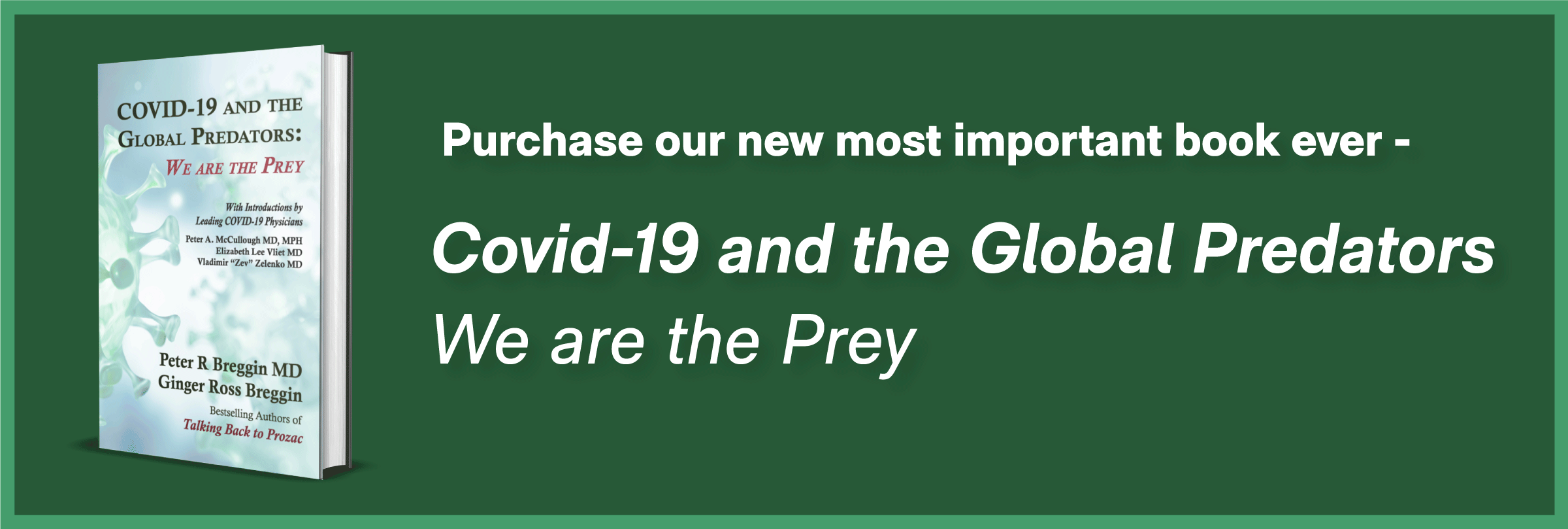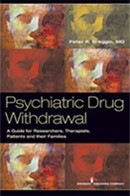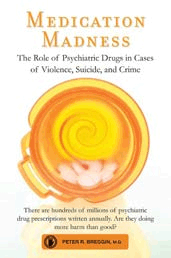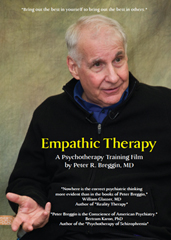Fauci Wants You Scared, Anxious, and Compliant– It’s Scientific!
By Ginger Ross Breggin and Peter R. Breggin M.D.
November 06, 2020
For more than 70 years a branch of public health science has been studying fear. But not to help humans cope. Seventy years of study have gone into how to scare people into compliance or submission in obeying public health officials and politicians. As it turns out, fear is a powerful motivator and can drive humans to be more easily manipulated into doing things they would ordinarily resist doing.
Few citizens realize that the government and public health scientists have put time, money and much effort into studying how to scare people into doing what the experts want us to do. The study of fear as a tool to manipulate individuals or populations is called “Fear Appeal.” It is a robust field of study within psychology and public health and has been widely used to intimidate us since the beginning of the pandemic.
Remember when a large group of public health experts, surrounding the President of the United States, announced that there was a new deadly disease loose in the US threatening us with the loss of 2.2 million lives if we did not take drastic measures. I remember the stone in the pit of my stomach, the abject fear that figure and that threat stirred. Two weeks to bend the curve morphed into six weeks, and six weeks has extended seemingly forever.
Now increasing numbers of people are feeling angry at being frightened by the pandemic and COVID-19. We have become aware of the constant release of new bits of bad news or predictions about the disease, and many of us have begun to push back against what some have labeled “panic porn.”[i] [ii] Other citizens, especially those with emotional vulnerabilities or who live in lockdown isolation, have suffered from months of the fear-inducing messages leading to depression, anxiety, panic attacks and hopelessness.
No one has been talking openly about this “scientific” form of scare tactics called “fear appeal.” Who knew that scaring us is actually science! Now we see this science being applied daily, especially by Dr. Anthony Fauci, the media face of the science that is used to justify the harshest shutdown measures.
A recent attempt by Dr. Fauci at fear-based influence occurred when he urged Americans to cancel their family Thanksgiving gatherings. [iii] [iv] He said “When you have people coming from out of town, gathering together in an indoor setting … it is unfortunate because that’s such a sacred part of American tradition, the family gathering around Thanksgiving, but that is a risk.”
More recently Fauci and the Washington Post used “fear appeal” to sway the election by making dire warnings about a Trump victory. With the presidential election day only 48 hours away on November 2, 2020, Fauci’s warnings about COVID-19 and President Trump’s handling of it became increasingly dire. The Washington Post offered this threatening headline:[v] ‘“A whole lot of hurt”: Fauci warns of covid-19 surge, offers blunt assessment of Trump’s response.’
The article went on to repeat and explain the ominous headline:
“We’re in for a whole lot of hurt. It’s not a good situation,” Anthony S. Fauci, the country’s leading infectious-disease expert, said in a wide-ranging interview late Friday. “All the stars are aligned in the wrong place as you go into the fall and winter season, with people congregating at home indoors. You could not possibly be positioned more poorly.”
More than 70 years of scientific research has gone into this field of fear appeal. [vi] As review authors Witte and Allen explain:
… evaluation of a fear appeal initiates two appraisals of the message, which result in one of three outcomes. First, individuals appraise the threat of an issue from a message. The more individuals believe they are susceptible to a serious threat, the more motivated they are to begin the second appraisal, which is an evaluation of the efficacy of the recommended response. If the threat is perceived as irrelevant or insignificant (i.e., low perceived threat), then there is no motivation to process the message further, and people simply ignore the fear appeal. In contrast, when a threat is portrayed as and believed to be serious and relevant (e.g., “I’m susceptible to contracting a terrible disease”), individuals become scared. Their fear motivates them to take some sort of action—any action—that will reduce their fear. Perceived efficacy (composed of self-efficacy and response efficacy) determines whether people will become motivated to control the danger of the threat or control their fear about the threat. When people believe they are able to perform an effective recommended response against the threat (i.e., high perceived self-efficacy and response efficacy), they are motivated to control the danger and consciously think about ways to remove or lessen the threat. Typically, they think carefully about the recommended responses advocated in the persuasive message and adopt those as a means to control the danger. Alternatively, when people doubt whether the recommended response works (i.e., low perceived response efficacy) and/or whether they are able to do the recommended response (i.e., low perceived self-efficacy), they are motivated to control their fear (because they believe it’s futile to control the danger) and focus on eliminating their fear through denial (e.g., “I’m not at risk for getting skin cancer, it won’t happen to me”), defensive avoidance (e.g., “This is just too scary, I’m simply not going to think about it”), or reactance (e.g., “They’re just trying to manipulate me, I’m going to ignore them”).
In other words, there have now been 70 years worth of study and analysis about
- How to frighten us into compliance by making us feel it personally as a risk to ourselves and loved ones
- How to suggest actions we can take to alleviate the fear
- How to tweak both the inducements of fear and the actions recommended to maximize the response to fear in favor of public health authoritarianism.
Feeling like a little white lab rat yet? There’s more.
In the new millennium fear appeal evolved from a primary focus on behavior relating to communicable diseases, to addressing chronic conditions that are often blamed on lifestyle choices.[vii] Who can forget those abhorrent stop smoking advertisements on television that featured very sick, very elderly people who were dying of cancers or other diseases caused by decades of smoking. The ads featured fear prominently and promised you could avoid that fate of illness, disfigurement, and death if you stopped smoking.
Using fear appeal is fraught with ethical issues and controversy. There are those professionals who feel that the attack on the mental well-being of those receiving the fear message is not justified by any positive outcome or change in behavior. And then, there are those scientists who feel that the ends justify the means, especially if society as a whole is better off because the fear campaign results in changes in behavior that lessen the threat. For example, the fearmonger scientists believe if we are told that millions could die in this pandemic in the U.S., but if we wash our hands for at least 20 seconds every chance we get we can lessen deaths, then it will be worth it if the death rate goes down.
The scientists and public health experts who use fear appeal are proving to be the same individuals who favor a top-down tightly controlled, authoritarian approach to managing a population. No encouragement of can-do Americanism. No appeal to our goodness. No inspiration to face the future with optimism and bravery. These doctors just want to terrify us.
Public health officials love fear-based messages as evidenced by the extensive use of fear in the current pandemic. From the first days where we were told over 2.2 million people would die in the U.S. and hospitals would be overrun and would collapse.[viii] We were told we needed to stay home for 2 weeks to protect hospitals from being overwhelmed and after the two weeks another month was added to the “stay home” period. After that, governors began locking down and issuing emergency orders in some states to “prevent spikes.”
Early on, those spike statistics were numbers of hospitalizations, and numbers of deaths. Then there was a little-discussed shift away from counting hospitalizations and deaths. Now the CDC counts the number of “cases” of COVID-19 meaning anyone who has tested positive even though only a tiny percentage of those testing positive will actually become seriously ill.
There is great news out there amid the tragedy: Numbers of deaths from COVID-19 have plummeted, even as numbers of cases have risen according to official statistics. That means increasing numbers of Americans are surviving the disease. Meanwhile we keep being told to be frightened and go into another shutdown because of the rise in “cases” that aren’t even sick.
Part of leadership is to help the involved members of the affected group stay strong and determined even in the face of dreadful fear and loss. Captains of ships, heads of state, and corporate leaders understand this. Consider when President Trump tries to help us feel reassured. The science experts who are fear mongers ridicule the President and dismiss him as dishonest when he is trying to offer hope and optimism in the face of this tragedy. He is like the captain of a ship in a squall, reassuring passengers that the storm will soon be over, even as the waves are breaking across the deck and tossing the ship about on the high seas.
Use of fear appeal by our government officials and pandemic experts has become rampant. Many of us sense we are being actively manipulated. During this present pandemic we have been left with having to figure out what information we are being given to scare us into conformity and what information we have been given simply because it is scary but true.
Dr. Fauci has become suspect in his pronouncements for several reasons:
First, Fauci has specific drugs that he favors for his croney corporations. He has been in his position as the National Institutes of Health (NIH) Director for the National Institute for Allergy and Infectious Diseases (NIAID) for 38 years. He has influenced the distribution of billions of dollars for specific treatments, especially Remdesivir,[ix] as well as for the development of vaccines to protect against COVID-19. Remdesivir was a bust and Fauci has already discouraged expectations for the vaccines.
Second, Fauci has shown his political hand in his latest paper, “Emerging Pandemic diseases: How We Got to COVID-19” in which he promotes his radical progressive vision by calling for a world where there is no human crowding and where we humans change our habits and thousands of years of social evolution.
Living in greater harmony with nature will require changes in human behavior as well as other radical changes that may take decades to achieve: rebuilding the infrastructures of human existence, from cities to homes to workplaces, to water and sewer systems, to recreational and gatherings venues. In such a transformation we will need to prioritize changes in those human behaviors that constitute risks for the emergence of infectious diseases. Chief among them are reducing crowding at home, work, and in public places as well as minimizing environmental perturbations such as deforestation, intense urbanization, and intensive animal farming. Equally important are ending global poverty, improving sanitation and hygiene, and reducing unsafe exposure to animals, so that humans and potential human pathogens have limited opportunities for contact.[x]
Another blog would be required to thoroughly examine the far-reaching consequences of so many changes in human nature and nurture.
Adults spend every day of their lives constantly factoring risks versus benefits in the decisions we make. Should we drive the mile to the store or walk? Should we eat that burger or have some dinner that is less high-fat? And we spend a great deal of time teaching our children how to evaluate risk and reward.
But the facts of the pandemic have continued to be muddied and manipulated so badly that the truth cannot be teased out. We are all being manipulated with misinformation.
My mother is a plucky, healthy and intelligent woman of 94 years of age who lives with us. She watches the news and keeps up with the current events. But when I asked, based on her impressions from watching the news, what she thought her chances were of dying were if she caught COVID-19, she believed she had a 75% chance of dying if she caught COVID-19.
In fact, at worst my mother’s actual chance of dying from COVID-19 is somewhere between 5.6% [xi]and 10%[xii] for anyone over 80 years old. Bear in mind that the statistics for all persons over 80 years old, include patients dying of a terminal illness, in full time nursing home care with chronic incapacitating illnesses such as congestive heart failure or COPD, or otherwise impaired and incapacitated. My mother’s chances of survival are much better.
We should be suspicious of anyone–expert, scientist, doctor or government official–who is trying to frighten us into doing anything more that hurts us, our culture and society, our religious practices, our education and the education of our children, and our friends, neighbors and citizens in our states and in our nation.
We are Americans. No task is too big or too overwhelming. It is time to heal ourselves, heal our communities and states and heal America.
There is a great deal of room for optimism.
Let’s make America well again!
[1] https://nypost.com/2020/04/19/enough-with-panic-porn-and-other-commentary/
[2] https://www.washingtontimes.com/news/2020/jun/30/mainstream-media-goes-all-in-with-panic-porn-over-/
[3] https://nypost.com/2020/10/15/fauci-warns-that-americans-may-need-to-cancel-thanksgiving/
[4] https://www.yahoo.com/lifestyle/dr-fauci-says-bite-bullet-110138091.html
[5] https://www.washingtonpost.com/politics/fauci-covid-winter-forecast/2020/10/31/e3970eb0-1b8b-11eb-bb35-2dcfdab0a345_story.html
[6] https://journals.sagepub.com/doi/pdf/10.1177/109019810002700506?casa_token=fxdqynSiiVAAAAAA:BuKUDEZRZ_cgUTBdefAzRQ99_rze4efddXAu00PdPztLy-pSzSBwjTcxw607uETiIeb-QZe3-SjD
[7] https://www.clinicalcorrelations.org/2011/11/23/ethical-considerations-on-the-use-of-fear-in-public-health-campaigns/
[8] https://www.nytimes.com/2020/03/16/us/coronavirus-fatality-rate-white-house.html
[9] https://breggin.com/faucis-remdesivir-inadequate-to-treat-covid-19-and-potentially-lethal/
[10] https://www.sciencedirect.com/science/article/pii/S0092867420310126
[12] https://www.washingtontimes.com/news/2020/aug/21/chances-of-getting-covid-19-are-slim-dying-from-it/





